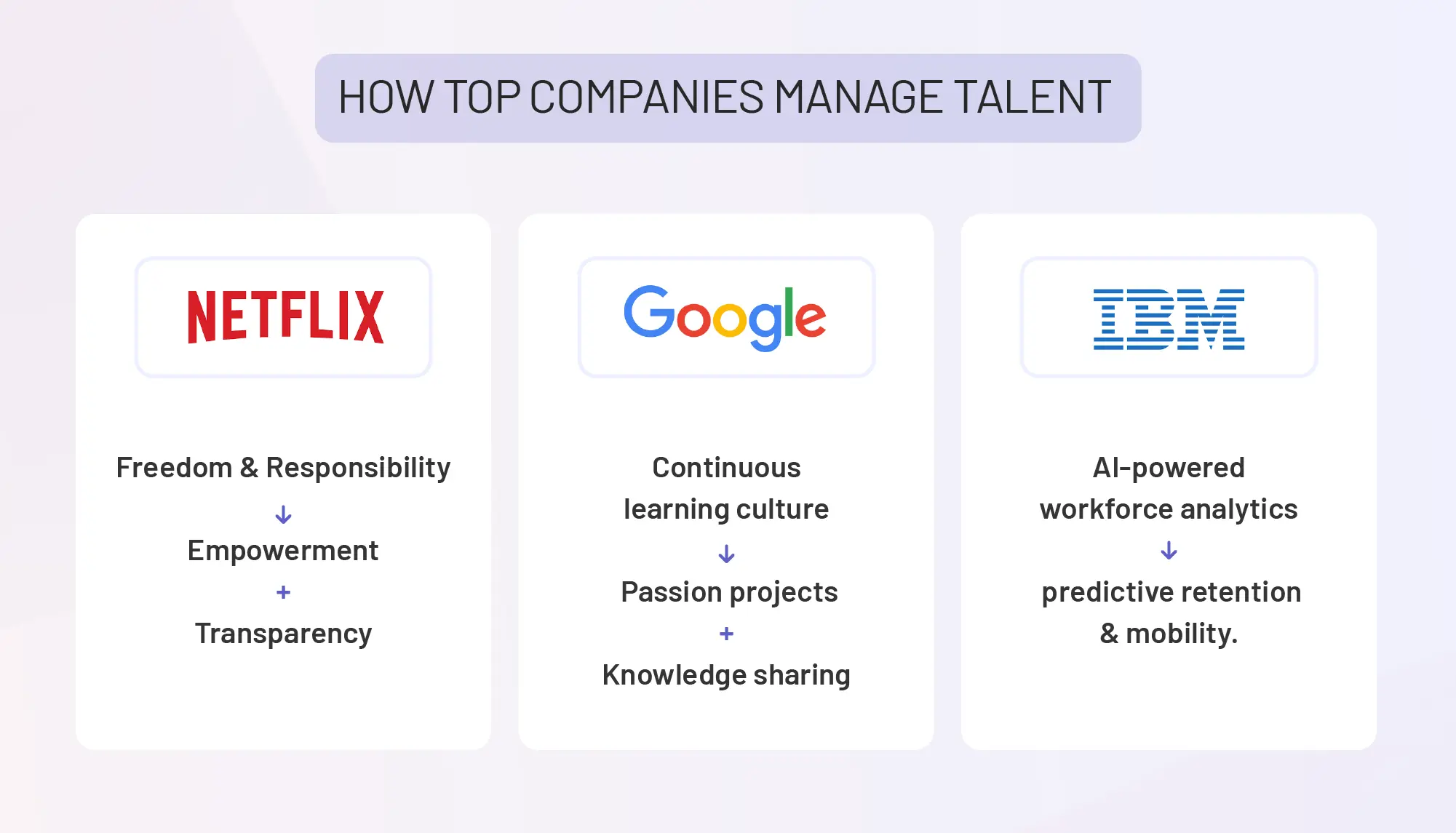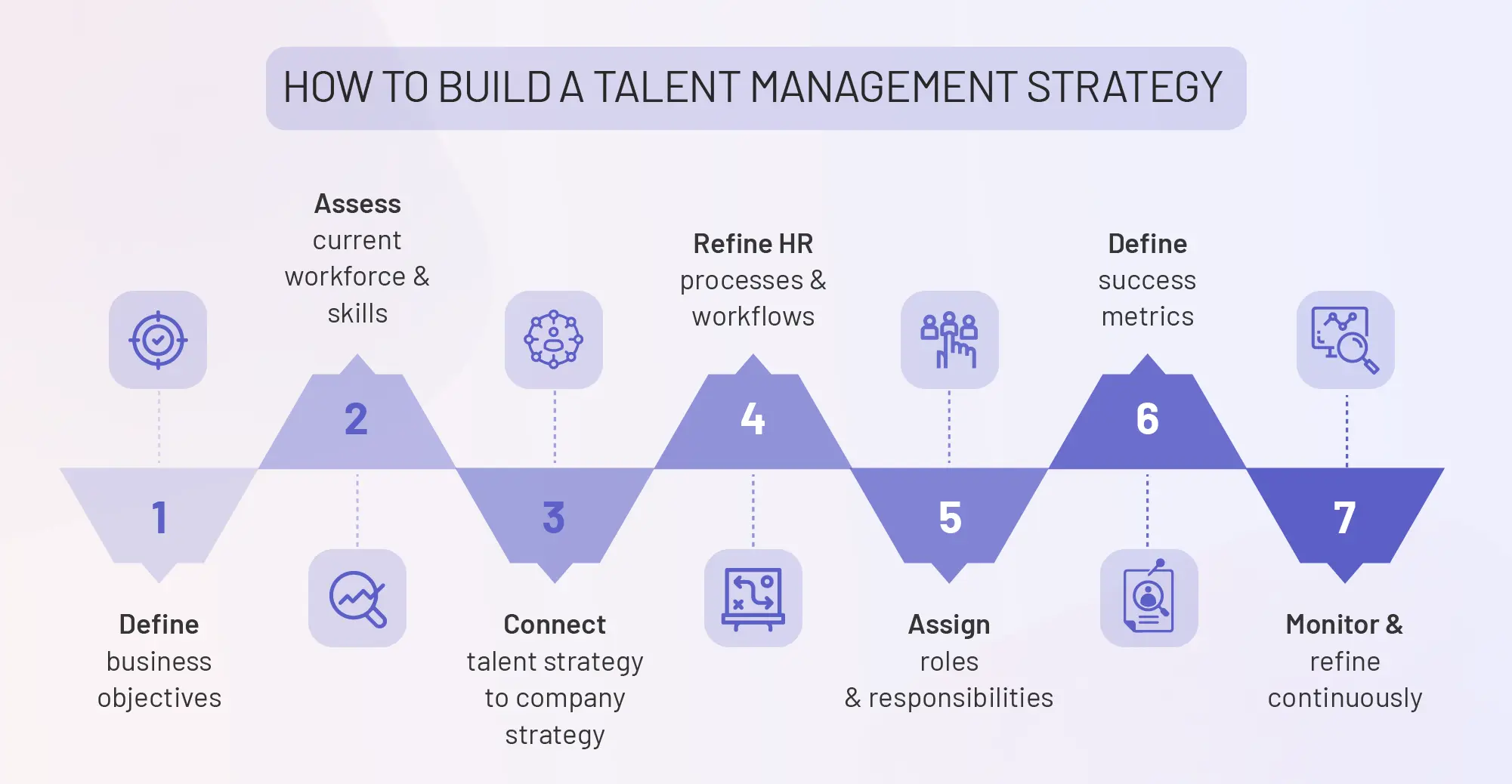The ability to build an effective talent management strategy is now the major factor separating companies that succeed from those that consistently face problems such as employee turnover, skill deficits, and unmotivated employees.
A systematic approach turns scattered HR initiatives into a unified framework called a talent management strategy, which directly supports your business objectives.
We’ve learned the best and worst practices for creating these frameworks. That’s exactly why we’ve created this guide covering everything from core strategy development to proven frameworks, real-world examples from leading companies, and the latest best practices for 2025.
A talent management strategy is a comprehensive, long-term plan that aligns an organization’s people practices with its business objectives to attract, develop, retain, and engage employees effectively.
It serves as the primary blueprint for building a workforce that actively contributes to your organization’s success and growth rather than simply filling seats.
An effective talent management strategy covers:
Talent management differs from talent development and other HR plans with its focus on connecting employees to your business purpose through clear goals and measurable impact.
Organizations with well-defined talent management strategies consistently outperform those without them. Strategic talent management creates measurable advantages in key areas that directly impact business success, including:
A well-implemented talent management plan is vital for business success, significantly influencing an organization’s ability to compete and expand within the existing market conditions.
As organizations adapt to rapid changes in the workforce, talent management is evolving beyond traditional HR processes. In 2025, companies are adopting more sophisticated strategies to attract, develop, and retain top talent. Below, we have listed some of the most important talent management strategies that organization's will need to implement in 2025.
If your organization hasn't embraced AI in its talent management process, then you might be behind the curve. SHRM reports 43% of organizations now leverage AI for HR tasks, up from 26% in 2024.
The role of AI in talent management cannot be stated enough. Data is becoming the backbone of effective talent management. AI-powered HR analytics tools help HR teams make informed decisions by analyzing vast amounts of workforce data.
Core Use-Cases for AI in Talent Analytics:
Employee expectations around career growth are shifting. Instead of static job roles, professionals now seek dynamic learning opportunities that help them adapt to new challenges. Organizations that encourage continuous learning not only retain their workforce longer but also build future-ready teams.
Once again, the numbers back this statement up. Companies with strong learning cultures have 30–50% higher retention rates. (Source: Deloitte)
Below are some of the initiatives you can implement as a part of your talent management strategy to build a culture of continuous learning and employee development.
Employee Development Initiatives:
Employees in 2025 prioritize a healthy work-life balance, and companies that offer flexible arrangements see higher retention and engagement levels. However, flexible working arrangements go beyond that simple perk. Different employees perform better under different specific working arrangements. Tailoring your models to find the best format for each employee is a great way to build a high-performance culture without burning your team out.
Sample Initiatives to Implement for Flexible Work
Real-World Talent Strategy Example:
Page Group, a leading recruitment firm, has championed flexible work arrangements, allowing employees to tailor their schedules to their personal commitments. This initiative has resulted in increased job satisfaction and productivity.
Employee well-being is now a core element of talent management. Organizations recognize that mental health and work-life balance directly impact productivity and retention.
Well-being Initiatives:
Some organizations are even introducing “mental health days” as part of their leave policies.
HR teams are also shifting their focus from reactive support (addressing stress once it becomes an issue) to proactive well-being strategies. Regular check-ins with employees, integrating task management tools to balance workload effectively, and conducting regular employee mental health survey all contribute to having a proactive approach to employee well-being and mental health.
Real-World Talent Strategy Example:
Spreetail, an e-commerce partner, has implemented a candidate experience initiative that emphasizes fast feedback and employee well-being. Their commitment to fostering a supportive work environment, enhanced overall retention and satisfaction.
In a competitive talent market, companies need more than high salaries to attract top talent. They need a compelling EVP that clearly communicates what makes them attractive.
What are the core components of a strong EVP?
While there are plenty of different factors that contribute to your value proposition as an organization, here are some of the most imporatant factors that contribute to an organization's employer value proposition in 2025.
Diversity initiatives are no longer about just hitting quotas or running unconscious bias training. Companies leading the way in DEI are embedding it into every stage of the employee experience, hiring, promotions, leadership pipelines, and even team structures.
And they do this for a very good reason:
In the study mentioned above, McKinsey has found that score in the top quartile n terms of racial diversity outperformed others by 35% while companies that had more gender diversity outperformed others by 15%.
Key Focus Areas:
Employee expectations around recognition have evolved. People want acknowledgment that feels timely, meaningful, and personal. Recognition in 2025 has to be a part of an organization’s culture.
Modern Recognition Approaches:
Leading organizations are embedding succession planning at every level of the business. That means identifying high-potential employees early in their careers and giving them structured opportunities to develop leadership skills, mentorship, and exposure to cross-functional projects.
Must-Have Components of a Succession Planning Strategy:

An internal talent marketplace is essentially a system that connects employees to opportunities within the company, whether that's open roles, short-term projects, mentorship connections, or skill-based gigs. Instead of waiting for promotions, employees can explore lateral moves, stretch assignments, or leadership pathways that align with their evolving interests.
Key Components:
Generic training programs often miss the mark because they assume every employee wants to develop in the same way. The reality is, professional growth is personal, and employees who feel their career path is truly supported are more likely to stay engaged.
Individual development plans throughout the years have gone through an evolution. While previously, employee development was seen through the scope of identifying areas of improvement and improving performance, individual development plans now are seen as tools advance an employee's career.
The modern IDP is more centered around where the employee wants their career to progress. This can be anything from identifying employee strengths to analyzing competency frameworks.
Modern IDPs include:
That being said, manual solutions like the template above have their limitations.
Companies investing in technology-driven IDPs make this process seamless.
To do this, you need a strong talent management software with built-in individual development plans that factor in other key aspects of talent management, such as performance review results, how the employee performed in their goals, role-related competencies, and more!
While there are plenty of impressive options out there when it comes to talent management, the best option for organizations using Microsoft Teams or Outlook is Teamflect.

Teamflect is an all-in-one solution that not only covers every single talent management step we covered in this article such as:
And so much more! You can try Teamflect for absolutely free with full functionality by clicking the button below!
The AARRR model creates a comprehensive cycle covering the entire employee experience, with each stage feeding into the next:
Each stage feeds into the next, creating a cohesive talent management system aligned with business objectives. This is one of many different frameworks used in talent management. Another useful model is the employee life cycle.

Your talent management strategy can be greatly enhanced by examining the practices of industry leaders. Companies like Netflix, Google, and IBM demonstrate how strategic talent management creates competitive advantages.
Netflix built its talent strategy around radical transparency and employee empowerment, creating a high-performance culture that scales globally.
Key Elements:
Results:
Netflix consistently ranks among the best places to work and has successfully scaled its culture globally while maintaining innovation and performance.
Lesson for Your Organization:
Trust employees with responsibility and provide the support they need to succeed. Clear expectations combined with autonomy drive exceptional performance when implemented consistently.
Google’s talent strategy centers on creating a culture of continuous learning and development that supports innovation across multiple business areas.
Key Elements:
Results:
Google maintains high employee satisfaction and retention while consistently innovating across multiple business areas.
Lesson for Your Organization:
Invest heavily in employee development and create opportunities for people to grow in multiple directions beyond traditional career advancement paths.
IBM has transformed its talent management using artificial intelligence and predictive analytics to make smarter, more proactive workforce decisions.
Key Elements:
Results:
IBM has improved retention rates and internal mobility while reducing time-to-fill for critical positions.
Lesson for Your Organization:
Use data and technology to make smarter talent decisions. Predictive analytics help you be proactive rather than reactive in managing your workforce effectively.

An effective talent management strategy demands systematic planning and execution to achieve measurable results aligned with business goals. It also requires ongoing commitment, resources, and continuous attention rather than a one-time effort.
Starting with the big picture ensures your talent strategy directly supports your business strategy. Your talent initiatives must align with organizational goals to create a meaningful impact.
Action Steps:
Understanding where you are today helps you plan where you need to go. An insightful workforce assessment reveals the gap between current capabilities and future requirements.
Action Steps:
Making explicit connections between your talent initiatives and business outcomes ensures every program contributes to organizational success. Clear alignment prevents the wasting of resources on initiatives that don’t support strategic goals.
Action Steps:
Ensuring your HR processes support your strategic objectives efficiently eliminates bottlenecks and creates consistency across all talent management activities.
Action Steps:
A talent strategy that clearly defines responsibilities fosters accountability, which helps to avoid misunderstandings and ensures consistent implementation across all organizational levels.
Action Steps:
Setting up clear methods to measure the impact and effectiveness of your strategy provides accountability and enables continuous improvement through data-driven decisions.
Action Steps:
Key Metrics to Track:
Your talent strategy should be a living document that adapts to changing needs. Regular evaluation and adjustment ensure your strategy remains effective as business conditions and employee expectations change.
Action Steps:
A cohesive system integrates workforce planning, talent acquisition, onboarding, performance management, learning and development, retention, engagement, and succession planning, all in line with business objectives.
To develop a talent management strategy, you need a structured approach that aligns talent initiatives with your business goals and adapts to changing needs. The key steps include:
The AARRR model (Acquisition, Activation, Retention, Referral, Renewal) is a valuable tool for understanding the employee journey, but the best model will depend on the unique needs of your organization, taking into account company culture and goals.
Use AI-driven recruitment, foster continuous learning, support hybrid work, prioritize employee well-being, promote diversity and inclusion, enhance employee value propositions, give real-time recognition, focus on skills development, and make data-driven, agile decisions.
An all-in-one performance management tool for Microsoft Teams
